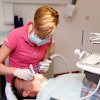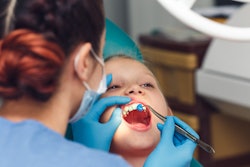
On September 15, 2022, the American Medical Association (AMA) approved a new Current Procedural Terminology (CPT) code for silver diamine fluoride (SDF) application by healthcare professionals to treat cavities without prepping the tooth for a filling. This code will go into effect on July 1, 2023.
This a huge step forward in medical-dental health integration and progress for oral health equity, providing access for millions of people who don't have access to a regular dentist, such as the rural poor in “dental deserts,” those living in poverty, and those without adequate transportation.
Why and how is SDF applied?
 Estela Vargas.
Estela Vargas.
SDF is a minimally invasive way to prevent dental caries from progressing. The brush-on liquid stops caries by strengthening affected tooth structures and inhibiting bacterial growth on teeth. There is no drilling and filling a cavity -- SDF is quick, painless, and does not require local anesthesia or sedation. It is terrific news for pediatric patients, the elderly, or anyone with a moderate to high risk of caries.
Based on studies conducted by the ADA:
● There is a growing appreciation of SDF to arrest caries lesions, which is an off-label use; SDF currently has FDA clearance as a desensitizing agent.
● The potential benefits of using SDF treatment for caries arrest include its low cost and ease of application.
● The potential harms of using SDF treatment for caries arrest include permanent black stains on the caries lesions and temporary gingival tattoos.
● Semiannual application of SDF is recommended for sustained benefit.
In the case of pediatric patients, informed consent is essential so the parent understands the possibility of black stains (permanent) on the treated teeth with lesions.
In addition, the World Health Organization updated its Model List of Essential Medicines for adults and children. Three of the 20 new medicines recommended are fluoride, glass ionomer cement, and SDF -- dental treatments that prevent caries, marking a significant achievement and opportunity for oral and public health.
What is the dental hygienist's role in applying SDF?
Can a hygienist apply SDF? In general, it depends on individual state scope-of-practice laws.
A dentist must have completed the diagnosis of incipient or mild/moderate caries, developed the treatment plan for the need for SDF, and actively monitored the patient to see if the carious lesion has arrested or is progressing and may require further treatment. The dental hygienist can then perform the procedure to place SDF on the patient's diagnosed areas under the dentist's direct supervision (depending on state-by-state laws).
What is the proper CDT code for SDF?
D1354 (interim caries arresting medicament application-per tooth) is the current dental code that best describes the application of SDF. According to the ADA, “It is a conservative treatment of an active, non-symptomatic carious lesion by topical application of caries arresting or inhibition medicament and without mechanical removal of sound tooth structure.” It is not brand-name specific.
When you are submitting a claim for this procedure, report the tooth numbers and the number of teeth treated on the claim’s service line that lists this procedure. It is reported the same as sealants: one tooth number per code. Insurance companies do not accept a range of teeth for the code.
Could ICD-10-CM diagnostic codes be used on the claim form?
ICD-10 codes (found in manuals) are medical diagnostic codes that group and identify diseases, disorders, and symptoms. Each diagnosis code is a unique, alphanumeric string of characters representing a disorder or disease concept. Consider the following:
● Z29.3: Encounter for prophylactic fluoride administration
● Z91.842: Risk for dental caries, moderate
● Z91.843: Risk for dental caries, high
● K02.3: Arrested dental caries (decay and cavities) (includes coronal and root caries)
● K02.51: Dental caries on pit and fissure surface limited to enamel
● K02.52: Dental caries on pit and fissure surface penetrating dentin
● K02.61: Dental caries on smooth surface limited to enamel
● K02.62: Dental caries on smooth surface penetrating dentin
● K02.7: Dental root caries
Is SDF a covered benefit?
Whether SDF is covered or not depends on the individual plan benefits and limitations by contract. Verifying the coverage before treatment is recommended.
An American Academy of Pediatric Dentistry survey conducted in April 2017 determined that 37% of state Medicaid dental plans currently reimburse for this procedure. With the addition of the CPT code, more medical carriers are expected to allow coverage for this FDA-approved preventive procedure.
Defining medical necessity
According to the AMA, medical necessity mandates the provision of healthcare services that a physician or other healthcare provider, exercising prudent clinical judgment, would provide to a patient to prevent, evaluate, diagnose, or treat an illness, injury, disease, or its symptoms and that the service is in accordance with generally accepted standards of medical practice (based on credible scientific evidence published in peer-reviewed literature). In all cases, documentation in the patient’s medical or dental record must be consistent with and support why the procedures were performed.
Tooth decay is the most common noncommunicable disease worldwide and can lead to serious health problems, including brain or heart infections if it is left untreated. Now, medical teams are empowered to administer SDF to impact their patients' overall health, especially those who are at higher risk of dental disease and are impeded from access to regular dental care.
Integration of medical and dental for documentation of SDF
Dentistry has been challenged to prove that dental disease is a medical necessity. Payers are requesting clinical notes instead of short written narratives for claims.
Within the last decade, we have been required to include ICD-10-CM and CPT codes on claim forms with medical and dental benefits. Before, the Code on Dental Procedures and Nomenclature (CDT) code was sufficient to file a claim. Integrating SDF to include dental and medical aspects of the treatment is a game changer for healthcare.
Estela Vargas, CRDH, is the founder and CEO of Remote Sourcing, a dental insurance billing and revenue recovery service. She is a graduate of Miami Dade College's dental hygiene program. Vargas' extensive background in the clinical arena of dentistry is coupled with her experience as a practice administrator and business executive.
The comments and observations expressed herein do not necessarily reflect the opinions of DrBicuspid.com, nor should they be construed as an endorsement or admonishment of any particular idea, vendor, or organization.



















